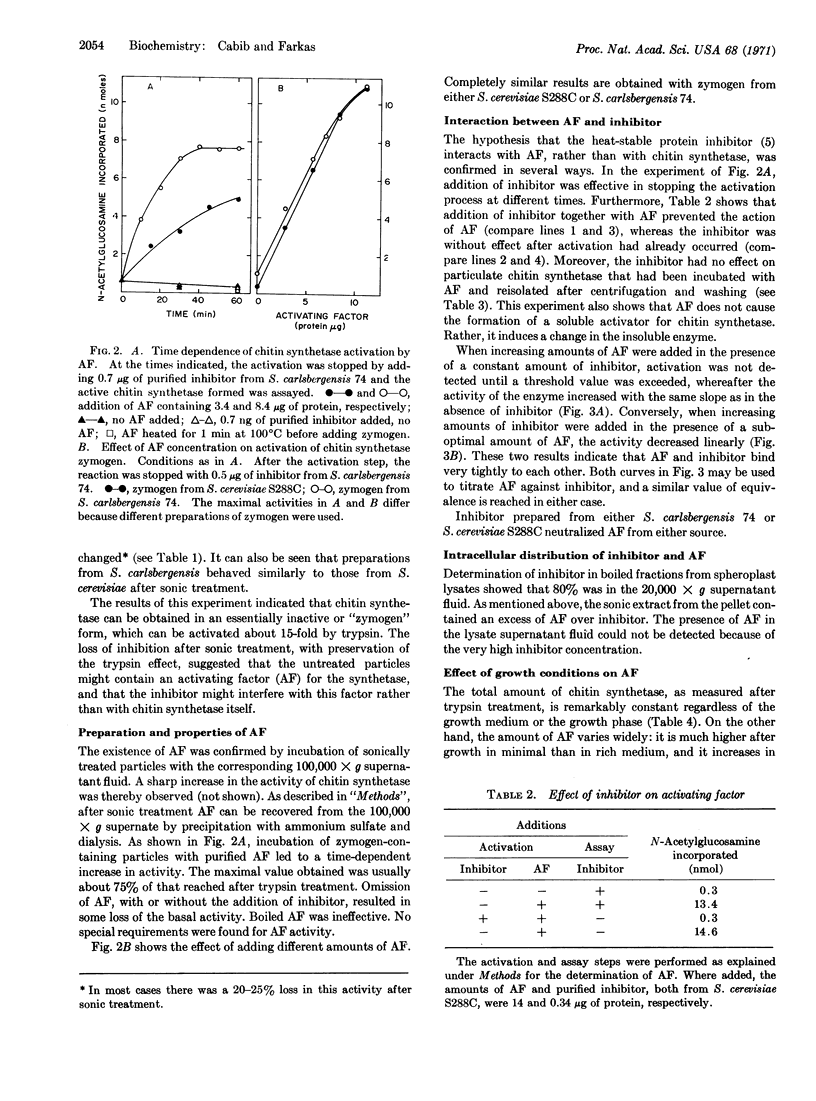Abstract
Previous work with yeast has indicated that chitin is the specific component of the septum between mother and daughter cell. Experiments with synchronized cells show that chitin synthesis is initiated at a precise time in the cell cycle. Newly discovered features of the chitin synthetase system suggest how this specificity in location and timing can be achieved. The particulate chitin synthetase is shown to exist almost entirely in an inactive or zymogen state. The zymogen can be converted into an active form either by an enzyme (activating factor) present in yeast or by trypsin. The activating factor is found in a particulate fraction, but can be solubilized by mild sonic oscillation. A heat-stable protein, previously isolated from yeast and believed to inhibit chitin synthetase, has now been found to act as an inhibitor of the activating factor to which it binds very tightly. It is proposed that chitin synthetase, in the zymogen form, is uniformly distributed on the cytoplasmic membrane. At the time of septum initiation, vesicles carrying the activating factor would be directed to specific sites and bring about the localized conversion of the zymogen into the active form. A molecular model is thus introduced for processes of morphological change and differentiation.
Keywords: chitin, zymogen, inhibitor, activating factor, proteolysis
Full text
PDF




Selected References
These references are in PubMed. This may not be the complete list of references from this article.
- Bacon J. S., Farmer V. C., Jones D., Taylor I. F. The glucan components of the cell wall of baker's yeast (Saccharomyces cerevisiae) considered in relation to its ultrastructure. Biochem J. 1969 Sep;114(3):557–567. doi: 10.1042/bj1140557. [DOI] [PMC free article] [PubMed] [Google Scholar]
- Cabib E., Bowers B. Chitin and yeast budding. Localization of chitin in yeast bud scars. J Biol Chem. 1971 Jan 10;246(1):152–159. [PubMed] [Google Scholar]
- Cabib E., Keller F. A. Chitin and yeast budding. Allosteric inhibition of chitin synthetase by a heat-stable protein from yeast. J Biol Chem. 1971 Jan 10;246(1):167–173. [PubMed] [Google Scholar]
- Keller F. A., Cabib E. Chitin and yeast budding. Properties of chitin synthetase from Saccharomyces carlsbergensis. J Biol Chem. 1971 Jan 10;246(1):160–166. [PubMed] [Google Scholar]
- PATTERSON M. S., GREENE R. C. MEASUREMENT OF LOW ENERGY BETA-EMITTERS IN AQUEOUS SOLUTION BY LIQUID SCINTILLATION COUNTING OF EMULSIONS. Anal Chem. 1965 Jun;37:854–857. doi: 10.1021/ac60226a017. [DOI] [PubMed] [Google Scholar]
- Sentandreu R., Northcote D. H. The formation of buds in yeast. J Gen Microbiol. 1969 Mar;55(3):393–398. doi: 10.1099/00221287-55-3-393. [DOI] [PubMed] [Google Scholar]


